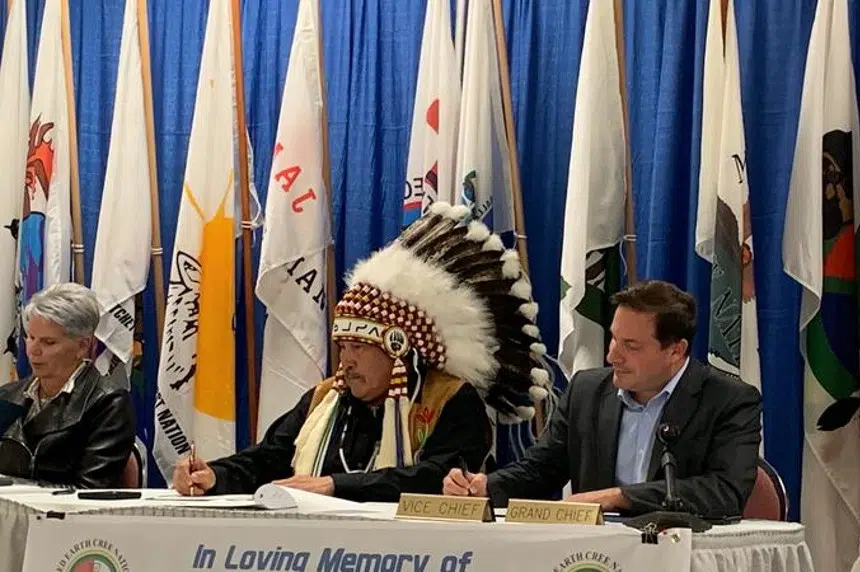By Derek Craddock
The path towards more Indigenous police services in Saskatchewan took another step forward Monday.
In a special ceremony in Prince Albert, the Prince Albert Grand Council (PAGC) signed a Letter of Intent with the federal and provincial governments, starting a process that will help create new public safety initiatives for the PAGC’s member nations.
The letter was signed by Grand Chief Brian Hardlotte, federal Public Safety Minister Marco Mendicino, and Saskatchewan Minister of Corrections, Policing and Public Safety Christine Tell.
Earlier that day Mendicino was at James Smith Cree Nation, the site of the deadly stabbings that claimed the lives of 10 people in the community and in nearby Weldon on Sept. 4.
Mendicino met with Chief Wally Burns, Chief Robert Head and Chief Calvin Sanderson along with the families of the victims.
“This is a community that remains awash in grief and trauma and loss but there’s also perseverance and real strength and that’s something I saw this morning,” said Mendicino.
Aside from hearing the stories from community members, Mendicino also spoke about the federal government’s new initiative that would designate policing on First Nations as an essential service.
Many communities in Canada have a tribal police force, with Siksika Nation near Calgary announcing the creation of a self-administered policing service for the community last month.
The Siksika force would join Tsuu T’ina, Lakeshore and Blood Tribe as the other First Nations that administer police services in Alberta.
According to the federal Public Safety website, there are currently 35 First Nations police services in Canada and one Inuit police service, serving 155 First Nations and Inuit communities.
They are located mainly in Ontario and Quebec, with a smaller presence across all Western Canadian provinces. Saskatchewan has one such police service: The File Hills First Nation Police Service in Balcarres.
Those services receive funding through the First Nations and Inuit Policing Program, which was created in 1991.
Many RCMP detachments serve First Nation communities, but some are not in the community themselves.
Head, the chief of the Peter Chapman First Nation, said while RCMP officers responded as quickly as they could on Sept. 4, they still had to drive about 40 minutes to arrive at James Smith.
“If we had our own First Nations police, we could have addressed the situation in minutes,” Head said.
He also mentioned the new public safety legislation should look at the future of infrastructure. He pointed to the lack of space in many communities for people to come together to grieve and heal from any sort of tragedy.
“Healing for First Nations people is a long-term process. We can’t do it overnight. We can’t heal in a week or a month or a year,” he said. “We have a whole cycle of healing to address.
“We need help. We need some kind of place or building where we can go and start the healing process.”
That was also addressed when Gov. Gen. Mary Simon visited the community last month.
Mendicino touched on the infrastructure needs following the signing of the Letter of Intent.
He said he received word that a wake service would be held for a member of James Smith Cree Nation on Monday. However, without a proper building, the community school had to be shut down to allow the wake to be held in the gymnasium.
“I think we can and should do better,” Mendicino said.
Infrastructure will be but one part of the Letter of Intent signed Monday as the first step will be to create a public safety team that will hear the specific needs from each member nation of the PAGC.
Vice Chief Joseph Tsannie of the PAGC said while police forces like the future one in Siksika will help inspire other police forces, there is no “one-size-fits-all” approach.
“We have 28 communities, and we have unique challenges with each of our First Nation communities,” he said. “We have to adjust to the needs in our communities.”
Tsannie noted the PAGC has been working on the possibility of introducing policing services since 2018 when it signed a resolution to look at community-based policing for 12 of its First Nations. He added the events at James Smith Cree Nation put the initiative back at the forefront.
“It’s unfortunate that things happen but certainly it did open a lot of positive doors for our negotiating and getting us to where we are today, but the work has been happening,” Tsannie said.
The federal legislation that could open the door to more First Nation police services doesn’t have a timeline, nor are there specifics regarding funding for such services.
Mendicino said he would like to see the legislation introduced as soon as possible but cautioned there needs to be thorough and respectful dialogue with communities, which he said is already happening.
While policing is the main focus of the legislation, Mendicino said that’s not the only issue it hopes to address.
“We need to look at ways to prevent crime from occurring in the first place,” he said. “That’s why making sure there is also support for culturally sensitive training, healing lodges, rehabilitation (and) reducing recidivism all has to go on concurrently, even as we’re empowering communities to create their own policing services if they wish to.”
The proposed legislation stems from a series of public engagement sessions on First Nations policing that began March 21, with the final report issued late last month.
The primary findings from the report were a desire to rework the First Nations policing funding framework, making the service essential for all communities and determining the roles of the federal and provincial governments and First Nations to make this a reality.
In the 2021 budget, the federal Liberals pledged $43.7 million over five years to co-develop a legislative framework that recognizes First Nations policing as an essential service.







